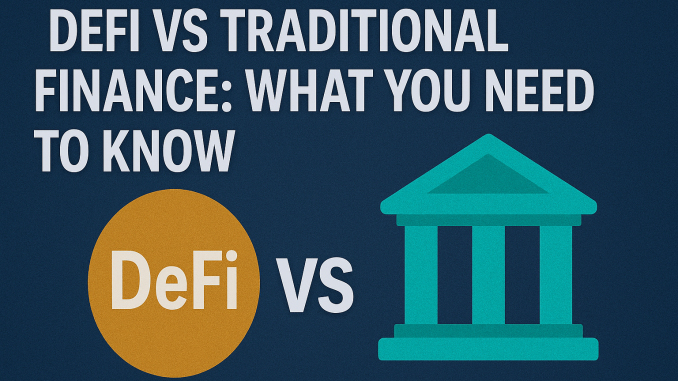
The rise of decentralized finance (DeFi) is reshaping how people borrow, lend, trade, and earn interest on money—all without banks or intermediaries. But how does DeFi compare to traditional finance? Is it truly better, or just hype?
In this guide, we break down the key differences between DeFi and traditional finance, the pros and cons of each system, and what this means for your money in 2025 and beyond.
What Is Traditional Finance?
Traditional finance (TradFi) refers to the conventional banking and financial system that has existed for centuries. It includes:
-
Banks (e.g., JPMorgan, HSBC)
-
Stock markets and brokers
-
Central banks (e.g., the Federal Reserve)
-
Credit card companies
-
Insurance and loan providers
Key Features:
-
Centralized control
-
Government regulation
-
Physical infrastructure (branches, paperwork)
-
Requires trust in institutions
SEO Keywords: what is traditional finance, how banks work, centralized financial system
What Is DeFi (Decentralized Finance)?
DeFi is a blockchain-based alternative to the traditional system. It lets users access financial services using smart contracts—no banks, no middlemen.
Key Platforms:
-
Uniswap – Decentralized exchange (DEX)
-
Aave – Borrowing/lending protocol
-
Compound – Interest-earning platform
-
MakerDAO – Stablecoin lending via DAI
Key Features:
-
Open to anyone with an internet connection
-
Powered by blockchain (mainly Ethereum, Solana, etc.)
-
Transparent, programmable, and permissionless
-
Smart contracts replace banks and brokers
SEO Keywords: what is DeFi, DeFi platforms 2025, decentralized finance explained
DeFi vs Traditional Finance: Key Differences
| Feature | Traditional Finance | Decentralized Finance (DeFi) |
|---|---|---|
| Control | Centralized institutions | Decentralized smart contracts |
| Access | Requires approval, KYC | Open to anyone, borderless |
| Speed | Slow (1–3 days) | Fast (minutes or seconds) |
| Fees | Bank/transaction fees | Lower or variable gas fees |
| Transparency | Limited (opaque systems) | Full transparency on blockchain |
| Security | Regulated, insured | Code-based, depends on audits |
| Innovation | Slow adoption | Rapid innovation, new products |
SEO Keywords: DeFi vs banking, DeFi comparison chart, DeFi vs centralized finance
Pros and Cons of DeFi
✅ Pros:
-
Full control over your assets
-
24/7 access with no middlemen
-
High yield opportunities (staking, farming)
-
Transparent code and operations
❌ Cons:
-
Smart contract bugs or hacks
-
No FDIC insurance or legal recourse
-
Volatile crypto markets
-
Learning curve for new users
Pros and Cons of Traditional Finance
✅ Pros:
-
Legal protections and regulation
-
Stable fiat currencies
-
Easier for mass adoption
-
Insurance on deposits (e.g., FDIC)
❌ Cons:
-
Slow, expensive international transfers
-
Limited access in underbanked regions
-
Restricted trading hours
-
Potential censorship or account freezes
SEO Keywords: banking vs crypto, DeFi risks, traditional finance problems
Will DeFi Replace Traditional Finance?
Not necessarily—but it could complement it. Many experts believe the future is “hybrid finance”, where traditional institutions integrate DeFi protocols to improve speed, efficiency, and global access.
Major banks and hedge funds are already exploring DeFi or launching blockchain-based services.
SEO Keywords: future of DeFi, hybrid finance, DeFi adoption by banks
Final Thoughts: Which One Is Right for You?
-
Use DeFi if you want full control, fast access, and are comfortable with crypto tools.
-
Stick with traditional finance if you prefer government protections and low-risk stability.
Either way, understanding both systems is essential in today’s evolving financial landscape.
🔍 Stay curious. Stay secure. And always DYOR (Do Your Own Research).
Leave a Reply